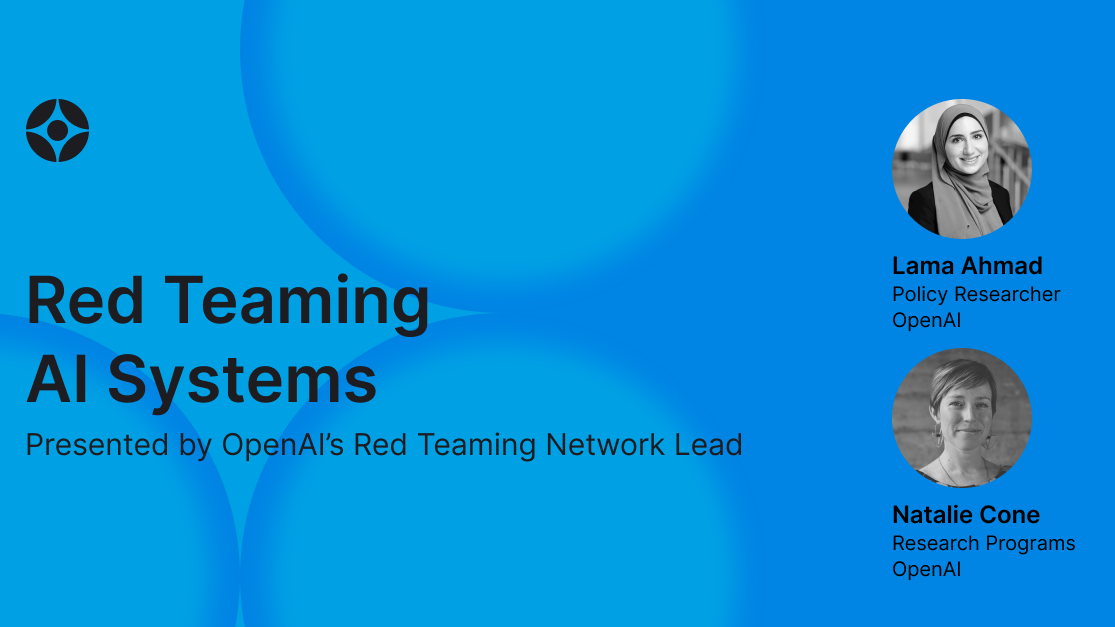“Mastering AI Security: A Comprehensive Guide to Red Teaming Techniques”
Summary
In a recent presentation at OpenAI, Lama Ahmad shed light on the organization’s proactive approach to red teaming AI systems, a crucial method for pinpointing risks and vulnerabilities within models aimed at enhancing their safety. Originating from cybersecurity practices, red teaming is vital for testing AI systems against harmful outputs and infrastructure threats under both adversarial and standard usage scenarios. Ahmad pointed out that red teaming is not a one-off task but a perpetual, collaborative effort that engages internal teams, external specialists, and automated frameworks to evaluate risks throughout different phases of AI development. Given the rising availability of AI tools like DALL-E 3 and ChatGPT, red teaming’s significance has intensified in unearthing potential threats across multiple fields.
During the session, Ahmad illustrated red teaming insights with practical examples, such as the identification of “visual synonyms” which users might exploit to navigate content restrictions. She underscored the role of automated techniques in red teaming while emphasizing that human assessments are indispensable for recognizing nuanced risks. When responding to audience inquiries, Ahmad delved into how red teaming combats misinformation and bias, especially concerning sensitive subjects like elections. She wrapped up by stressing the necessity for ongoing enhancements in red teaming strategies as AI systems advance in intricacy, advocating for a blend of human expertise and automation to cultivate safer, more dependable AI solutions.
Key Takeaways
Lama Ahmad’s talk centered on OpenAI’s red teaming processes. Natalie Cone, OpenAI’s Community Manager, kicked off the session by introducing Ahmad and mentioning an engaging project opportunity concerning cybersecurity. She reiterated OpenAI’s commitment to ensuring that artificial general intelligence (AGI) serves humanity positively. The core discussion revolved around the imperative of red teaming AI systems, a pivotal safety practice.
Key Points from Lama Ahmad’s Presentation
Background on Red Teaming:
Red teaming in AI originates from cybersecurity, having transformed to meet the unique demands of the AI sector. It is a methodical process designed to examine AI systems for harmful capacities, outputs, or infrastructural threats. The ultimate aim is to surface risks to enact safeguarding measures and communicate those risks effectively.
Red teaming examines both adversarial applications of AI and typical user actions that may lead to undesirable results due to quality or precision shortcomings.
Evolution of Red Teaming at OpenAI:
Ahmad discussed the evolution of OpenAI’s red teaming initiatives, highlighting early efforts such as the launch of DALL-E 3 and subsequent systems like ChatGPT. She emphasized the significance of accessibility in AI and its implications for assessing AI system risks.
Lessons from Red Teaming:
Red teaming presents a comprehensive policy challenge, initiating at the ideation stage of model development and necessitating collaboration across diverse fields, involving external and internal teams. Diverse viewpoints are crucial to comprehend potential model failures and their implications.
Automated red teaming utilizes AI models to create additional test scenarios, while the engagement of human evaluators remains essential for context-sensitive and intricate testing.
Red teaming facilitates both mitigation strategies and enhancements in model safety at various deployment stages.
Challenges and Future Directions:
As AI systems grow increasingly sophisticated, red teaming processes must adapt, melding human-in-the-loop evaluations with automated approaches to counter emerging risks. The significance of public input and cross-industry collaboration was underscored, with OpenAI focusing on acquiring diverse insights to foster the creation of safer systems.
Examples of Red Teaming:
Ahmad shared findings from red teaming, such as the identification of visual synonyms (i.e., using similar terms to circumvent content bans) and the potential misuse of features like DALL-E’s inpainting tool, which allows users to modify images.
Q&A Session:
Audience inquiries covered various aspects of red teaming across different sectors (e.g., life sciences and healthcare), along with the difficulty of striking a balance between mitigation efforts and avoiding overly sanitized model outputs. Lama stressed that red teaming serves as a tool for risk assessment rather than a conclusive remedy, advocating for the right equilibrium between safety and functionality. Other discussions included managing misinformation in elections, automation in red teaming, and contextual red teaming, emphasizing the need for cultural and geopolitical considerations in model behavior.
Conclusion
Lama concluded by asserting the significance of iterative deployment and cross-industry cooperation in red teaming endeavors, noting that while automated assessments hold value, human participation is vital in detecting emerging risks. She reaffirmed OpenAI’s commitment to advancing model safety through consistent evaluation and input from varied stakeholders. The session wrapped up with Natalie Cone sharing details about upcoming events and how participants could engage in future OpenAI initiatives.
Extended Summary
In a recent talk at OpenAI, Lama Ahmad shared fascinating insights into OpenAI’s Red Teaming efforts, which are essential for safeguarding and validating AI systems. The event was moderated by Natalie Cone, OpenAI Forum’s Community Manager, who opened with a call for audience involvement in cybersecurity projects at OpenAI. The primary spotlight was on red teaming AI systems, a structured strategy for uncovering risks and vulnerabilities to bolster their durability.
As Ahmad elucidated, red teaming, while rooted in cybersecurity, has evolved to cater specifically to the AI landscape. Essentially, it is a systematic endeavor to probe AI systems for harmful outputs and infrastructural threats stemming from both normal and adversarial use. Red teaming tests systems against possible misuse as well as evaluates standard user behaviors to unearth accidental failures or perilous recurrences, such as erroneous results. Ahmad, who leads OpenAI’s external assessments of AI system impacts, asserted that these red teaming initiatives are fundamental to constructing safer and more reliable technologies.
Ahmad also chronicled the trajectory of OpenAI’s red teaming ventures in parallel with product development. She remarked that with milestones like the launch of DALL-E 3 and ChatGPT, the accessibility of AI tools has significantly increased—which enhances red teaming’s importance in evaluating risks across different user domains. With broad accessibility comes the responsibility to assess the associated risks AI could pose to various user groups.
Among the critical insights shared were several lessons gleaned from the red teaming processes at OpenAI. First, she defined red teaming as a multi-faceted policy challenge, requiring coordination across a spectrum of teams and expert domains. It is not merely a task triggered at a singular point in time; it needs to be seamlessly integrated throughout the AI development lifecycle. Furthermore, understanding potential failure modes demands diverse perspectives, and OpenAI engages both internal resources and external experts alongside automated systems to probe risks. The emerging role of automated red teaming—utilizing AI to generate test scenarios—is proving indispensable, though Ahmad asserted that human expertise is crucial to grasping the intricate risks that automated methods may overlook.
Ahmad mentioned specific findings from red teaming efforts, including the revelation of visual synonyms, enabling users to bypass imposed content restrictions with alternate phrases. Additionally, she pointed out the complications of features like DALL-E’s inpainting tool, which provides users the ability to modify image portions, underscoring the need for both qualitative and quantitative risk assessments. Often, the conclusions drawn from red teaming yield model-level adjustments, system-wide safeguards like keyword blocklists, or even policy frameworks designed to ensure ethical AI application.
During the Q&A session, attendees raised a host of questions regarding red teaming challenges across industries like life sciences and healthcare, where sensitivity could lead to overly cautious outputs. Ahmad reassured participants that red teaming functions as a tool for continual risk tracking rather than as a one-size-fits-all solution. Other topics touched on the threats of misinformation in AI systems surrounding electoral processes. Ahmad confirmed that OpenAI is actively addressing these challenges with red teaming efforts focused specifically on bias and misinformation concerns.
In closing, Ahmad reiterated that as AI systems continue to evolve, red teaming efforts must also progress—integrating human evaluations with automated approaches to enhance risk assessments. She highlighted OpenAI’s iterative deployment model, which permits the company to learn from practical applications, ensuring consistent system improvements. Despite the usefulness of automated evaluations, human involvement remains key in managing novel risks and constructing safer, reliable AI frameworks.






